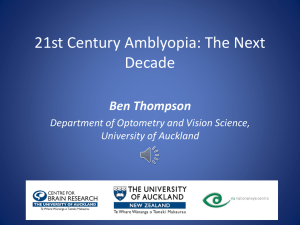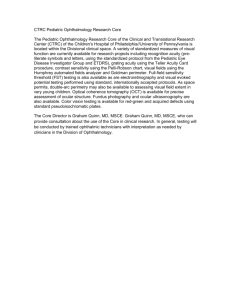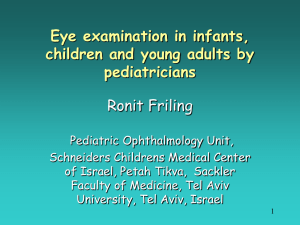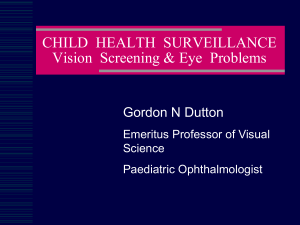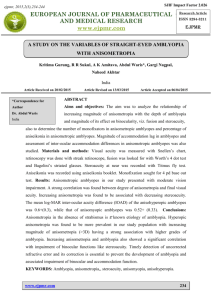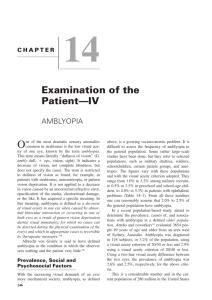Amblyopia: - Icon Lasik
advertisement
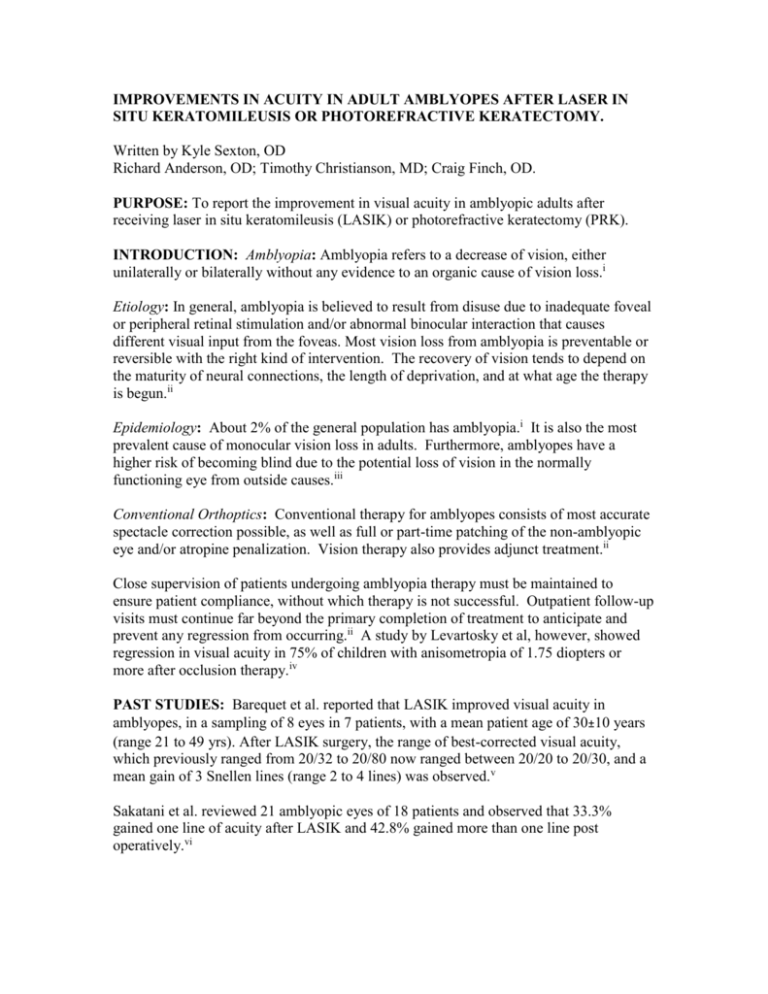
IMPROVEMENTS IN ACUITY IN ADULT AMBLYOPES AFTER LASER IN SITU KERATOMILEUSIS OR PHOTOREFRACTIVE KERATECTOMY. Written by Kyle Sexton, OD Richard Anderson, OD; Timothy Christianson, MD; Craig Finch, OD. PURPOSE: To report the improvement in visual acuity in amblyopic adults after receiving laser in situ keratomileusis (LASIK) or photorefractive keratectomy (PRK). INTRODUCTION: Amblyopia: Amblyopia refers to a decrease of vision, either unilaterally or bilaterally without any evidence to an organic cause of vision loss.i Etiology: In general, amblyopia is believed to result from disuse due to inadequate foveal or peripheral retinal stimulation and/or abnormal binocular interaction that causes different visual input from the foveas. Most vision loss from amblyopia is preventable or reversible with the right kind of intervention. The recovery of vision tends to depend on the maturity of neural connections, the length of deprivation, and at what age the therapy is begun.ii Epidemiology: About 2% of the general population has amblyopia.i It is also the most prevalent cause of monocular vision loss in adults. Furthermore, amblyopes have a higher risk of becoming blind due to the potential loss of vision in the normally functioning eye from outside causes.iii Conventional Orthoptics: Conventional therapy for amblyopes consists of most accurate spectacle correction possible, as well as full or part-time patching of the non-amblyopic eye and/or atropine penalization. Vision therapy also provides adjunct treatment.ii Close supervision of patients undergoing amblyopia therapy must be maintained to ensure patient compliance, without which therapy is not successful. Outpatient follow-up visits must continue far beyond the primary completion of treatment to anticipate and prevent any regression from occurring.ii A study by Levartosky et al, however, showed regression in visual acuity in 75% of children with anisometropia of 1.75 diopters or more after occlusion therapy.iv PAST STUDIES: Barequet et al. reported that LASIK improved visual acuity in amblyopes, in a sampling of 8 eyes in 7 patients, with a mean patient age of 30±10 years (range 21 to 49 yrs). After LASIK surgery, the range of best-corrected visual acuity, which previously ranged from 20/32 to 20/80 now ranged between 20/20 to 20/30, and a mean gain of 3 Snellen lines (range 2 to 4 lines) was observed.v Sakatani et al. reviewed 21 amblyopic eyes of 18 patients and observed that 33.3% gained one line of acuity after LASIK and 42.8% gained more than one line post operatively.vi METHODS: This study is retrospective review of adult patients previously diagnosed with amblyopia, who underwent LASIK or PRK correction for their ametropia. Lasers used were the Nidek EC-5000 and VISX S3/S4. Data and candidacy for the procedure were based on manifest refraction, cyclopledged refraction, keratometry, pachymetry, intraocular pressure, corneal topography, anterior segment evaluation, and dilated fundus examination. Post-operative exams took place 1 day, 1 week, 1 month, 3 months, 6 months and 1 year after the initial procedure. All patients used an antibiotic and steroid drop four times per day for 5 days, and preservative-free artificial tears for 4 times per day for 1 month post-op. Manifest refractions and best-corrected visual acuity (BCVA) were assessed at the 1 month, 3 months, 6 months, and 1 year post-op evaluations. DIAGNOSTIC CRITERIA: For this study, amblyopia was assessed as a two or more line difference of BCVA between eyes on a standard Snellen chart, or a BCVA of 20/40 or worse. All patients of this study had amblyopia due to anisometropia or high bilateral refractive error. No strabismic amblyopes were included.iii RESULTS: 23 eyes of 17 patients were included, with a mean patient age of 35 years (range 23 to 52 yrs). Mean preoperative BCVA in the amblyopic eye was 20/48, ranging from 20/30 to 20/80, with an average spherical component of –7.42 diopters sphere (DS) (range -17.75 to +7.25), and an average cylindrical component of –2.47 diopters cylinder (DC) (range –5.50 to 0.00). At 3 months post-op, the mean BCVA in the amblyopic eye was 20/30, with a range of 20/40 to 20/20. The average spherical correction was +0.09 DS, with a mean cylindrical correction of –0.58 DC. On average, the amblyopic patients gained 2 lines of acuity, but ranged from 1 to 4 lines of improvement. Each patient reported significant subjective improvement and satisfaction with the results, and continued to have stable acuity at the 6-month and annual check-up. LASIK vs. PRK: Some patients had PRK as opposed to LASIK due to various factors that made them better candidates for PRK, such as decreased corneal thickness and large refractive error. LASIK patients (n=7) had an average initial BCVA of 20/44. At 3 months post-op this acuity had improved to an average of 20/29. PRK patients (n=16) had an average initial BCVA of 20/70. At the 3 months check, the PRK patients had an average BCVA of 20/40. Although the PRK patients on average gained 3 lines of acuity, and the LASIK patients gained 1.5 lines, the ratio of improvement for PRK versus LASIK was proportionally almost equal due to the initial BCVA of PRK patients being lesser than that of the LASIK patients. The ratio of initial acuity versus post-op acuity in LASIK patients was 0.66 while it was 0.57 in PRK patients. There was no significant difference. DISCUSSION: As opposed to the findings on regression of acuity found by Levartosky et al. when standard occlusion therapy was implemented, no regression in visual acuity has been observed in any of the patients in this study. By permanently correcting the amblyogenic refractive error, patients were provided with constant focused visual stimuli, which effectively remediated their amblyopia, despite conventional thought that adults with amblyopia cannot be effectively treated with success. Studies have shown that treatment of amblyopia after “visual maturity,” which occurs around the age of 9, can improve not just visual acuity, but overall visual functioning. Nevertheless, many clinicians do not treat amblyopia if patients appear “too old”.vii Subjectively, all patients in this study expressed an improvement in quality of life after having refractive surgery. All results were attained without the use of vision therapy, and were based on a best optical correction. The same correction that did not offer increased acuity when used alone. The only factor in the patients’ vision that was altered was corneal thickness and composition. It can be hypothesized; therefore, that photoabation of the cornea during LASIK or PRK is physiologically altering not only the refraction of the patient, but any corneal properties that prevent better acuity with refraction alone. Further studies on this hypothesis can be accomplished by monitoring higher-order aberrations using WaveScanTM technology before and after refractive surgery to determine if the newly thinner cornea is increasing the possibility of improved acuity via physiological change within the cornea itself, as opposed to refractive or neuronal limitations hindering acuity. i BARRET, BRENDAN T., BRADLEY, ARTHUR, MCGRAW, PAUL V. Understanding the Neural Basis of Amblyopia. NEUROSCIENTIST 10(2):106-117, 2004. ii YEN, KIMBERLY G. Amblyopia. EMEDICINE. 08/16/2004:1-12. iii CALOROSO, E. E.; ROUSE, M. W.; Clinical Management of Strabismus. Butterworth & Heineman, Stoneham, MA, 1993. iv LEVARTOVSKY S, OLIVER M, GOTTESMAN N, SHIMSHONI M. Factors affecting long term results of successfully treated amblyopia: initial visual acuity and type of amblyopia. BR J OPHTHALMOL. 1995 Mar;79(3):225-8. v BAREQUET, IRINA S. MD; WYGNANASKI-JAFFE, MD; HIRSCH, AMI, MD. Laser in situ Keratomileusis Improves Visual Acuity in Some Adult Eyes with Amblyopia. JOURNAL OF REFRACTIVE SURGERY. 20(1) Jan-Feb 2004. vi SAKATANI, KEIKO, MD; JABBUR, NADA S., MD; O’BRIEN, TERRENCE P., MD. Improvement in Best Corrected Visual Acuity in Amblyopic Adult Eyes after Laser in Situ Keratomileusis. vii LEE, R. Active Vision Therapy on an Adult Strabismic Amblyope. JOURNAL OF BEHAVIORAL OPTOMETRY, 10(5), 1999.
